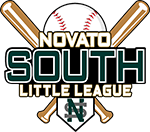LOCAL RULES
**IMPORTANT INFORMATION REGARDING DE-CERTIFIED BATS**

White Paper: Common Misinterpreted Rules
Below is a quick reference to commonly mis-interpreted Little League Rules.
This doc is a supplement to NSLL Local Rules and quick reference of Little League Blue Book Rules
Table of Contents:
1. There is no must slide rule
2. Runner out of the baseline
3. Infield fly
4. Leaving the base early. Everyone goes back.
5. Hit By Pitch
6. Pitcher’s Undershirt
7. Batting out of order
8. Batter hits a ball that bounced off the dirt – the ball is live
1. There is no must-slide rule (Blue book - 7.08 a):
Reference: https://www.littleleague.org/university/articles/hey-blue-that-player-has-to-slide/
The runner has three options when the fielder has the ball and is waiting to make the tag.
a) Slide (note: runner cannot slide head first advancing to a base, result = out)
b) Attempt to get around the fielder (the runner gets 3 FEET)
c) Go back to the previous base
If the runner arrives before or simultaneously with the ball, the fielder must yield the base. If the fielder remains in the way, the runner must slide or go around the fielder and will be SAFE due to obstruction. If there is contact the runner will be OUT
2. Out of the baseline (blue book 7.08a1):
References:
• https://www.littleleague.org/university/articles/hey-blue-the-runner-is-out-of-the-baseline/
• https://app1.siplay.com/Files/GetEncoded?Id=642f62564256474376734e7a654d4733426164654c673d3d
Confusion is often with the definition of “baseline”. It is not necessarily the direct line between two bases. The runner establishes the baseline. For example, if the runner takes a wide turn at first into the second baseman's normal position, the baseline goes from the runner to the base. If the fielder tries to tag the runner, the runner cannot deviate more than three feet to either side of this line.
Also, the runner is not out of the baseline unless he’s avoiding a tag. If he’s running around a fielder who is trying to field a batted ball, there is no violation.
3. Infield Fly (Green book 2.00):
Infield Fly is in effect when:
a) Runners are at first and second or bases loaded
b) Less than two outs
c) Umpire determines a fly can be caught with “ordinary effort”
In AA and AAA the Infield Fly rule will only be called rarely due to “ordinary effort” considerations at this age.
An umpire may retro-actively enforce Infield Fly, if a defense fails to catch the ball and makes an easy force or double play.
Note - The ball is live during an infield fly. Once the ball is touched or hits the ground the runners advance at their own risk
4. Leaving the base early (Blue book 7.13):
Reference: https://baseballrulesacademy.com/user/official-rules/ll/7-13-base-runner/
If a runner leaves a base before the pitch reaches a batter, (or before the ball is caught in a tag up situation), all runners are guilty and must return to the previous occupied base.
If the pitch is hit, play resumes – however runners return to the closest base they occupied before the pitch.
• If runners are on 2nd and 3rd and the ball is a base hit, the runners will remain at 2nd and 3rd. If the batter hits a double, the runner at third will score, the runner at second would advance to 3rd.
• If bases are loaded and the batter hits a single, runners advance one base. The lead runner will not be recorded as a run.
In a tag-up situation the runner may be tagged out or doubled-off. And/or the defensive team may appeal.
5. Hit By Pitch Scenarios (Green book 6.08(b)):
Reference: https://www.littleleague.org/university/articles/explanation-of-hit-by-a-pitch-rule/
Whether the batter is entitled to first base depends on the scenario.
• The batter does not attempt to get out of the way and the ball is out of the strike zone – Ball
• The ball is in the strike zone over the plate - Strike
• The batter swings and then is hit – Strike
• The batter is hit then swings – HBP
• The ball hits the ground bounces up and hits the batter – HBP
• The batter does not swing and is hit in the hands – HBP (Blue book 6.08(b) the hands are part of the body)
6. Pitcher Undershirt:
Reference: https://www.littleleague.org/university/articles/answering-the-questions-parents-ask/
Any part of the pitcher’s undershirt that can be seen must be a solid color. The sleeves cannot be white or gray. Neoprene sleeves, if worn by a pitcher, must be covered by an undershirt. Also, a pitcher cannot wear anything on their hands, wrists or arms that may be distracting. There is no rule against pitchers wearing eye black.
7. Batting out of order (blue book 2.00):
Reference: https://www.littleleague.org/university/articles/hey-blue-the-batted-out-of-order/
The ruling is dependent on when the umpire is alerted
a) If the out of order AB is in progress, the correct batter replaces the out of order batter and resumes the count.
b) If the out of order batter has completed the AB but the next batter has not seen a pitch, the proper batter is ruled out and the next batter is up (even if this is the player who was out of order). Runner advances made due to improper batter AB (hits) are nullified. Advances made by stolen base, wild pitch or passed ball are legal and resume.
c) If the next batter sees a pitch the out of order batter has become legalized in this instance and play resumes.
8. Batter hits a ball that bounced off the dirt (blue book 2.00):
Reference: https://www.littleleague.org/university/articles/hey-blue-that-pitch-bounced-its-a-dead-ball/
A pitch is any ball delivered to the batter. The batter may hit any pitch thrown. It doesn’t matter how the pitch reaches the plate. Note - A pitch that bounces before reaching the plate may never be called a strike or a legally-caught third strike.
QUICK LINKS

FOLLOW US!